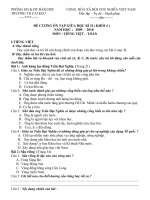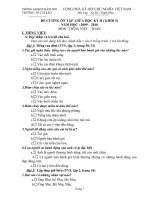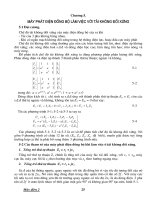Palladium (II) catalyzed 5 endo epoxynitrile cyclizations total syntheses of enokipodins a and b
Bạn đang xem bản rút gọn của tài liệu. Xem và tải ngay bản đầy đủ của tài liệu tại đây (522.7 KB, 5 trang )
Tetrahedron Letters 51 (2010) 2232–2236
Contents lists available at ScienceDirect
Tetrahedron Letters
journal homepage: www.elsevier.com/locate/tetlet
Palladium (II) catalyzed 5-endo epoxynitrile cyclizations: total syntheses
of enokipodins A and B
Jesús Armando Luján-Montelongo, José G. Ávila-Zárraga *
Facultad de Química, Universidad Nacional Autónoma de México, D.F., 04510, Mexico
a r t i c l e
i n f o
Article history:
Received 23 January 2010
Revised 8 February 2010
Accepted 12 February 2010
Available online 19 February 2010
a b s t r a c t
New total syntheses of the cuparenic sesquiterpenes enokipodins A and B were accomplished. The key
step involves a novel, cationic-controlled and palladium (II) improved, 5-endo cyclization of an a-aryld-epoxynitrile. The cyclization occurs with unmatched regioselectivity and high stereoselectivity. The
synthesis is completed in 5 steps achieving yields of 50% for enokipodin A and 55% for enokipodin B.
Ó 2010 Elsevier Ltd. All rights reserved.
Enokipodins A–D (1–4) are four cuparenic sesquiterpenes isolated from the edible mushroom Flammulina vellutipes (Enokitake)
by Ishikawa et al.1 From this specie, a variety of compounds with
pharmacological activity have been isolated.2 Being structurally
similar to coprinol3 (5) and lagopodin A4 (6) (Fig. 1), in terms of
their polycyclic skeleton, enokipodins show similar biological
activity against the Gram-positive bacteria Bacillus subtilis and
Staphylococcus aureus;1,3,4 however, they were ineffective against
Gram-negative bacteria.3
It’s been recognized that cuparenic sesquiterpenes are interesting
synthetic targets5–9 due to the difficulty on constructing the quaternary carbon centers over the cyclopentane moiety. Concerning the
stated above, enokipodins A–B (1–2) have been attractive to screen diverse methodologies intended to build cyclopentanic systems9a–c as
well as the application of asymmetric building protocols for benzylic
centers.9d–f There is no doubt enokipodins have been the most recurring synthetic targets among all the oxidized cuparenic species.
Although the RCM,5 dicarbonyl compound intramolecular condensation6 and cyclobutane rearrangment7 are frequently chosen
as cuparene-type sesquiterpene syntheses methodologies, the
intramolecular nucleophilic displacement8 hasn’t been a widely
accepted approach to assemble the cyclopentane system on those
compounds. As expected, the enokipodin’s five-membered system
is mainly synthesized by the first three approaches only.9
Recently, we reported a study regarding the cyclization of aaryl-d-epoxynitrile type compounds featuring a novel cationic metal regioselectivity control.10 This type of regiocontrol is barely
known;11 however, an analogous control has been found in reactions which show divergence in their stereoselectivity by the
involvement of different alkaline cations.12 It was found the use
of lithium or potassium salts of the hexamethyldisilamide base
in these systems, employing high boiling point hydrocarbonated
* Corresponding author. Tel.: +525 556 223 784; fax: +525 556 223 722.
E-mail address: (J.G. Ávila-Zárraga).
0040-4039/$ - see front matter Ó 2010 Elsevier Ltd. All rights reserved.
doi:10.1016/j.tetlet.2010.02.072
solvents, promote a 5-endo pathway of cyclization; on the other
hand, sodium hexamethyldisilamide in low boiling hydrocarbonated solvents leads to 4-exo cyclizations. Therefore, it could be proposed the Stork cyclization (Scheme 1)13 could be applied not
only in constructing cyclobutane-containing molecules originally
stated by the author, but to species which include cyclopentanic
rings like cuparenic derivatives as well.
These results established that Lewis’ acids involved in these systems had an important effect in terms of reaction regioselectivity
which could be directly translated to control the carbocycles proportion in the product mix. This is a complementary work to previous studies where the cyclization preferred pathway was
attributed just to the reagent’s sterical profile,13,14 and became
possible the regiochemical outcome modification by modulating
experimental conditions and base.
Figure 1. Enokipodins A–D (1–4) and some related oxidized cuparenic species.
2233
J. A. Luján-Montelongo, J. G. Ávila-Zárraga / Tetrahedron Letters 51 (2010) 2232–2236
Scheme 3. Synthesis of the d-epoxynitrile 9.
Table 1
Lewis acid catalyzed d-epoxynitrile 9 anionic cyclization study
Scheme 1. Cation controlled regioselective cyclizations of a-aryl-d-epoxynitriles.
Keeping this in mind we decided to include in this type of cyclization other acidic species, in order to evaluate if an additional 5endo promotion could emerge to improve yield of cyclopentanic
structures over cyclobutanic with no chemo and stereoselectivity
sacrifice whatsoever. In that way, we developed a new divergent
route towards the enokipodins A and B (1, 2) total syntheses by
employing a methodology based on intramolecular nucleophilic
carbocyclization of an a-aryl-d-epoxynitrile which features high
regioselectivity by alkaline metal cationic modulation, assisted by
additional Lewis acids.
Scheme 2 depicts the retrosynthetic plan for Enokipodins A and
B (1, 2). It was expected that cyclopentanone 7 could be precursor
a
b
c
Entry
Base
Catalyst
Cat. load (% mol)
Yielda (%)
8a:8bb
1
2
3
4
5c
6
7
8
9
10c
11
12
13
14
15
KHMDS
KHMDS
KHMDS
KHMDS
KHMDS
KHMDS
KHMDS
KHMDS
KHMDS
KHMDS
KHMDS
KHMDS
DIPEA
—
LHMDS
—
Ti(OiPr)4
InCl3
Cu(OTf)2
Cu(OTf)2
BiI3
Bi(OTf)3
Sc(OTf)3
PdCl2
PdCl2
PdCl2
PdCl2
PdCl2
PdCl2
PdCl2
—
20
20
20
20
20
20
20
20
20
10
5
10
10
5
90
20(60)
79
60
74
27
0(100)
19
65
79
80
85
0(100)
0(100)
80
2.8:1
2.9:1
1:2.1
1:4.9
3:1
2.2:1
—
3.7:1
1:4.8
3.2:1
1:4.7
1:4.9
—
—
1.2:1
Parentheses indicate the recovered yield of epoxynitrile 9.
Determined by 1H NMR of the crude product.
In these cases benzene was used as solvent.
Scheme 2. Retrosynthetic plan for the enokipodins syntheses.
2234
J. A. Luján-Montelongo, J. G. Ávila-Zárraga / Tetrahedron Letters 51 (2010) 2232–2236
of 1 and 2, as described by Srikrishna.9a Key intermediate 9 synthesis was conducted as shown in Scheme 3. Starting from 2,5-dimethoxy-4-methylphenyl acetonitrile10,15 (11), homoisoprenilic oxide
moiety was constructed by an alkylation–oxidation protocol.10
With d-epoxynitrile 9 on hand, we looked for the regioselectivity improvement of its cyclization by adding Lewis acids (Table 1).
Considering epoxynitrile cyclization, comparable in some way to
an intramolecular aldolic reaction, applied criteria attempted to
mimetize these species catalytic role, especially on Pd(II),16
Cu(II),17 Ti(IV),18 Sc(III),19 In(III)20 y Bi(III)21 cases. Furthermore,
some of these metals are involved in epoxide catalytic openings.22
As shown on Table 1, both PdCl2 (entry 9) and Cu(OTf)2 (entry 4)
are outstanding catalysts to enhance regioselectivity when the
reaction was carried out with KHMDS in toluene (which showed
best results at the absence of any additive). However, the reaction
where Pd (II) took part, showed the best yield as well as a ‘‘cleaner”
profile (entry 9). Once the appropriate catalyst was selected, the
best result was achieved with a 5% mol of PdCl2 (entry 12), which
kept good regioselectivity and slightly improved yield. As we anticipated, reactions in benzene didn’t show preference on the 5-endo
pathway (entries 5 and 10).
5-Endo promotion effected by PdCl2 can be understood by
inspecting two presumably side effects (Scheme 4). First, PdCl2
could be forming a coordination entity, where nitrogen of the cyano function could participate in the metallic core, in such way that
a rearrangement would take place into, changing from an N-coor-
dinated to O-coordinated specie. At this point, once activated the
oxiranyl function and promoting the C–O bond weakening of the
more substituted carbon, 5-endo pathway would be accessible.
Alternatively, regiospecific formation of a chlorohydrin intermediate23 could take place, fixing the reactive position on the more
substituted carbon. Interestingly, usage of lithium base showed
poor regioselectivity (Table 1, entry 15) and usage of DIPEA or absence of base afforded no cyclization products (Table 1, entries 13
and 14). This way, it was established that both base nature and
metallic counter-ion are essential to achieve good regioselectivity.
Important to mention Lewis acid catalized cyclization is completely stereoselective; this was concluded by inspecting 1H
NMR, 13C NMR and GC/EIMS spectra on both regioisomers. The
cyclopentanic isomer relative stereochemistry (8b) was assigned
as like by means of NOESY experiments (vide infra).
Next step involved the reduction of cyano to methyl and oxidation of hydroxyl group of the cyclopentane moiety (Scheme 5). At
first step, cyanocyclopentyl alcohol 8b was treated with DIBAH
(along with the corresponding acidic workup) affording an aldehyde derivative which was used with no further purification in
the next step. The Huang-Minlon24 procedure applied to the residue yields the reduced cyclopentanol 13 in an outstanding yield
(2 steps, 97%). Later on, cyclopentenone 7 was obtained in 87%
yield by Dess–Martin25 oxidation of 13, which was slightly inferior
but less harmful to the environment compared to PCC oxidation
(91%).26
Scheme 4. Possible pathways of PdCl2 assisted 5-endo cyclization of 9.
J. A. Luján-Montelongo, J. G. Ávila-Zárraga / Tetrahedron Letters 51 (2010) 2232–2236
2235
Marisela Gutiérrez, Margarita Guzmán, Nayeli López and Georgina
Duarte for all their valuable assistance at acquiring spectral data.
Supplementary data
Scheme 5. Preparation of precursor 7.
Supplementary data (experimental procedures and spectral
data for compounds 1–2, 7, 8a–b, 13) associated with this article
can be found, in the online version, at doi:10.1016/j.tetlet.2010.
02.072.
References and notes
Figure 2. Relevant NOE correlations of 13.
Scheme 6. Final steps on enokipodins A and B (1, 2) syntheses.
It’s remarkable the exhaustive reduction effected by the DIBAH
- Huang-Minlon sequence doesn’t epimerize any stereogenic center as confirmed by 1D NMR and NOESY experiments (Fig. 2).
Having enokipodin’s precursor 7 available, we proceed with the
enokipodin B (2) synthesis final step by oxidative cleavage using
CAN. The yield is excellent, almost identical to results shown by
Srikrishna9a and Kuwahara.9d On the other hand, the acidic cleavage-cyclization of 7 was carried out employing cyclohexyl iodide,27
allowing the access to enokipodin A (1) in good yield (93%).
In conclusion, we have accomplished enokipodins A and B syntheses by employing a cation-controlled regioselective ring opening of a tertiary epoxynitrile which follows predominantly a
‘non-favored’ palladium-catalyzed 5- endo pathway. As catalyst,
PdCl2 has proved to be suitable to enhance regioselectivity; however, other Lewis acids such as Cu(OTf)2 can be useful as well.
Although it was proposed a tentative explanation in regards the
achieved high regioselectivity at the key step, other effects could
be involved in the process as shown within the additional experiments where other bases were employed. As spectroscopic analyses revealed, cyclization occurs with high diasteroselectivity;
therefore, this methodology would provide a synthetic tool for
stereoselective generation of two contiguous quaternary centers
(Scheme 6).
Acknowledgments
This research work was sponsored by Facultad de Química
UNAM and CONACYT via a PhD scholarship granted to Ph.D. J. A.
Luján-Montelongo. Special thanks to Rosa Del Villar, Nuria Esterau,
1. (a) Ishikawa, N. K.; Yamaji, K.; Taharab, S.; Fukushi, Y.; Takahashi, K.
Phytochemistry 2000, 54, 777; (b) Ishikawa, N. K.; Fukushi, Y.; Yamaji, K.;
Tahara, S.; Takahashi, K. J. Nat. Prod. 2001, 64, 932.
2. (a) Zhang, H.; Gong, F.; Feng, Y.; Zhang, C. Int. J. Med. Mushrooms 1999, 1, 89; (b)
Breene, W. M. J. Food Prot. 1990, 53, 883; (c) Wasser, S. P.; Weis, A. L. Crit. Rev.
Immunol. 1999, 19, 65; (d) Wang, H.; Ng, T. B.; Ooi, V. E. C. Mycol. Res. 1998, 102,
897; (e) Yaoita, Y.; Amemiya, K.; Ohnuma, H.; Furumura, K.; Masaki, A.;
Matsuki, T.; Kikuchi, M. Chem. Pharm. Bull. 1998, 46, 994; (f) Hirai, Y.; Ikeda, M.;
Murayama, T.; Ohata, T. Biosci. Biotechnol. Biochem. 1998, 62, 1364; (g) JiunnLiang, K.; Chyong-Ing, H.; Rong-Hwa, L.; Chuan-Liang, K.; Jung-Yaw, L. Eur. J.
Biochem. 1995, 228, 244; (h) Wang, H.; Ng, T. B. Life Sci. 2001, 68, 2151; (i)
Leung, M. Y. K.; Fung, K. P.; Choy, Y. M. Immunopharmacology 1997, 35, 255.
3. Johansson, M.; Sterner, O.; Labischinski, H.; Anke, T. Z. Naturforsch. 2001, 56c,
31.
4. Bu’Lock, J. D.; Darbyshire, J. Phytochemistry 1976, 15, 2004.
5. Some of the recent examples of the RCM approach: (a) Srikrishna, A.; Babu, R.
R.; Ravikumar, P. C. Synlett 2007, 655; (b) Kulkarni, M. G.; Davawala, S. I.;
Shinde, M. P.; Dhondge, A. S.; Borhade, S. W.; Chavhan, D. D.; Gaikwad, A. P.
Tetrahedron Lett. 2006, 47, 3027; (c) Chavan, S. P.; Dhawane, A. N.; Kalkote, U. R.
Tetrahedron Lett. 2007, 48, 965.
6. Some examples of the dicarbonyl condensation approach (see also references
within): (a) Shindo, M.; Sato, Y.; Shishido, K. J. Org. Chem. 2001, 66, 7818; (b)
Anand, R. C.; Ranjan, H. Indian J. Chem. 1985, 24B, 673; (c) Meyers, A. I.; Lefker,
B. J. Org. Chem. 1986, 51, 1541.
7. Some of the recent examples of the cyclobutane rearrangement approach (see
also references within): (a) Bernard, A. M.; Floris, C.; Frongia, A.; Piras, P. P.
Tetrahedron 2004, 60, 449; (b) Ho, T.-L.; Chang, M.-H. Can. J. Chem. 1997, 75,
621; (c) Nemoto, H.; Ishibashi, H.; Nagamochi, M.; Fukumoto, K. J. Org. Chem.
1992, 57, 1707.
8. (a) Chavan, S. P.; Dhawane, A. N.; Kalkote, U. R. Synthesis 2007, 3827; (b) Tapas,
P.; Ashutosh, P.; Mukherjee, D. ARKIVOC 2003, ix, 104; (c) Tapas, P.; Ashutosh,
P.; Gupta, P. D.; Mukherjee, D. Tetrahedron Lett. 2003, 44, 737; (d) Ávila-Zárraga,
J. G.; Maldonado, L. A. Chem. Lett. 2000, 5, 512.
9. By RCM: (a) Srikrishna, A.; Srinivasa Rao, M. Synlett 2004, 374; (b) Srikrishna,
A.; Vasantha Lakshmi, B.; Ravikumar, P. C. Tetrahedron Lett. 2006, 47, 1277; By
cyclobutane rearrangement: (c) Secci, F.; Frongia, A.; Ollivier, J.; Piras, P. P.
Synthesis 2007, 999; By dicarbonyl intramolecular condensation: (d) Kuwahara,
S.; Saito, M. Tetrahedron Lett. 2004, 45, 5047; (e) Kuwahara, S.; Saito, M. Biosci.
Biotechnol. Biochem. 2005, 69, 374; (f) Yoshida, M.; Shoji, Y.; Shishido, K. Org.
Lett. 2009, 11, 1441.
10. Luján-Montelongo, J. A.; Vázquez-Sánchez, A.; Ávila-Zárraga, J. G. Heterocycles
2009, 78, 1955.
11. The regioselectivity control approach by the modulation of the cation in the
basic salt was de facto not known. To our knowledge, there was only one
example of the regioselectivity modulation in nucleophilic epoxide
intramolecular opening by modification of the base: Corbel, B.; Durst, T. J.
Org. Chem. 1976, 41, 3648.
12. (a) Stork, G.; Gardner, J. O.; Boeckman, R. K., Jr.; Parker, K. A. J. Am. Chem. Soc.
1973, 95, 2014; (b) Stork, G.; Boeckman, R. K., Jr. J. Am. Chem. Soc. 1973, 95,
2016; (c) Hu, Y.; Bishop, R. L.; Luxenburguer, A.; Dong, S.; Paquette, L. Org. Lett.
2006, 8, 2735; (d) Paquette, L. A.; Hu, Y.; Luxenburguer, A.; Bishop, R. L. J. Org.
Chem. 2007, 72, 209; (e) Spivey, A. C.; Shukla, L.; Hayler, J. F. Org. Lett. 2007, 9,
891.
13. (a) Stork, G.; Cama, L.; Coulson, D. R. J. Am. Chem. Soc. 1974, 96, 5268; (b) Stork,
G.; Cohen, J. F. J. Am. Chem. Soc. 1974, 96, 5270.
14. Lallemand, J. Y.; Onanga, M. Tetrahedron Lett. 1975, 585.
15. Standridge, R. T.; Howell, H. G.; Gylys, J. A.; Partyka, R. A.; Shulgin, A. T. J. Org.
Chem. 1976, 19, 1400.
16. (a) Sodeoka, M.; Tokunoh, R.; Miyazaki, F.; Hagiwara, E.; Shibasaki, M. J. Org.
Chem. 1995, 60, 2648; (b) Sodeoka, M.; Shibasaki, M. Pure Appl. Chem. 1998, 70,
411.
17. (a) Evans, D. A.; Murry, J. A.; Kozlowski, M. C. J. Am. Chem. Soc. 1996, 118, 5814;
(b) Evans, D. A.; Kozlowsky, M. C.; Murry, J. A.; Burgey, C. S.; Campos, K. R.;
Connell, B. T.; Staples, R. J. J. Am. Chem. Soc. 1999, 121, 669.
18. (a) Yachi, K.; Shinokubo, H.; Oshima, K. J. Am. Chem. Soc. 1999, 121, 9465; (b)
Crimmins, M. T.; Carroll, C. A.; King, B. W. Org. Lett. 2000, 2, 597; (c) Crimmins,
M. T.; Chaudhary, K. Org. Lett. 2000, 2, 775; (d) Mahrwald, R.; Ziemer, B.
Tetrahedron Lett. 2002, 43, 4459.
19. (a) Kobayashi, S. Synlett 1994, 689; (b) Kobayashi, S. Eur. J. Org. Chem. 1999, 15.
2236
J. A. Luján-Montelongo, J. G. Ávila-Zárraga / Tetrahedron Letters 51 (2010) 2232–2236
20. (a) Mukaiyama, T.; Ohno, T.; Sik Han, J.; Kobayashi, S. Chem. Lett. 1991, 20, 949;
(b) Kobayashi, S.; Busujima, T.; Nagayama, S. Tetrahedron Lett. 1998, 39, 1579;
(c) Muñoz-Muñiz, O.; Quintanar-Audelo, M.; Juaristi, E. J. Org. Chem. 2003, 68,
1622.
21. (a) Yamamoto, H.; Abell, J. P. Synfacts 2008, 378; (b) Ollevier, T.; Mwene-Mbeja,
T. M. Can. J. Chem. 2008, 86, 209; (c) Le Roux, C.; Gaspard-Iloughmane, H.;
Dubac, J. J. Org. Chem. 1993, 58, 1835.
22. Cu(II): (a) Pineschi, M.; Del Moro, F.; Crotti, P.; Di Bussolo, V.; Macchia, F.
Synthesis 2005, 334; Ti(IV): (b) Cole, B. M.; Shimizu, K. D.; Krueger, C. A.;
Harrity, J. P. A.; Snapper, M. L.; Hoveyda, A. H. Angew. Chem., Int. Ed. Engl. 1996,
35, 1668; Pd(II): (c) Imi, K.; Yanagihara, N.; Utimoto, K. J. Org. Chem. 1987, 52,
23.
24.
25.
26.
27.
1013; Bi(III): (d) Pinto, R. M. A.; Salvador, J. A. R.; Le Roux, C. Tetrahedron 2007,
63, 9221.
Mincione, E.; Ortaggi, G.; Sirna, A. J. Org. Chem. 1979, 44, 1569.
(a) Huang-Minlon J. Am. Chem. Soc. 1946, 68, 2487; (b) Huang-Minlon J. Am.
Chem. Soc. 1949, 71, 3301.
(a) Frigerio, M.; Santagostino, M.; Sputore, S. J. Org. Chem. 1999, 64, 4537; (b)
Ireland, R. E.; Liu, L. J. Org. Chem. 1993, 58, 2899; (c) Meyer, S. D.; Schreiber, S. L.
J. Org. Chem. 1994, 59, 7549.
Srikrishna, A.; Vasantha Lakshmi, B. V.; Ravikumar, P. C. Tetrahedron Lett. 2006,
47, 1277.
Zuo, L.; Yao, S.; Wang, W.; Duan, W. Tetrahedron Lett. 2008, 49, 4054.









